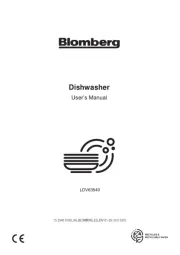Blomberg DWT81800SS Manual
Læs gratis den danske manual til Blomberg DWT81800SS (47 sider) i kategorien Opvaskemaskine. Denne vejledning er vurderet som hjælpsom af 8 personer og har en gennemsnitlig bedømmelse på 4.3 stjerner ud af 4.5 anmeldelser.
Har du et spørgsmål om Blomberg DWT81800SS, eller vil du spørge andre brugere om produktet?

Produkt Specifikationer
| Mærke: | Blomberg |
| Kategori: | Opvaskemaskine |
| Model: | DWT81800SS |
Har du brug for hjælp?
Hvis du har brug for hjælp til Blomberg DWT81800SS stil et spørgsmål nedenfor, og andre brugere vil svare dig
Opvaskemaskine Blomberg Manualer










Opvaskemaskine Manualer
- Classique
- Summit
- V-Zug
- Limit
- Eurotech
- Frilec
- Vestfrost
- Boretti
- WLA
- Stirling
- OK
- Arçelik
- Kenmore
- Danby
- Stoves
Nyeste Opvaskemaskine Manualer









